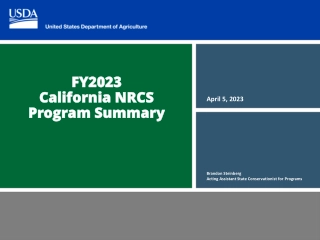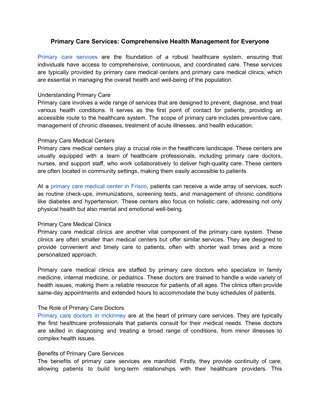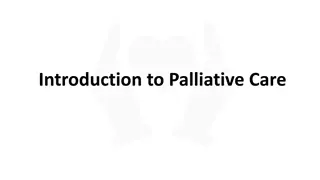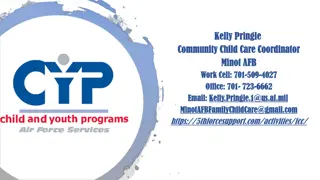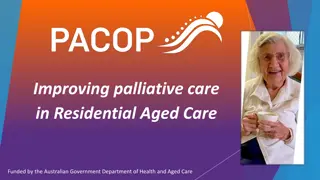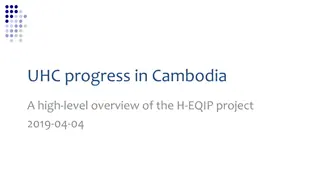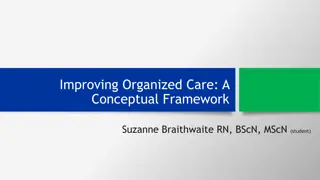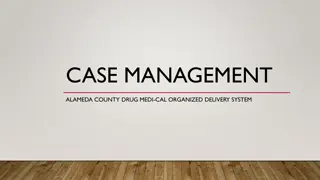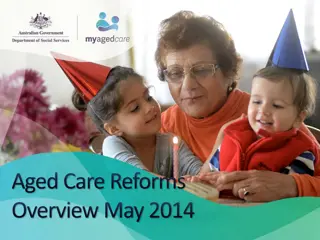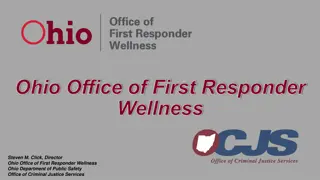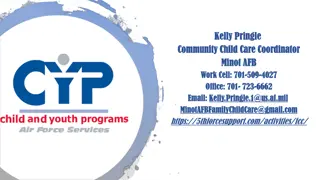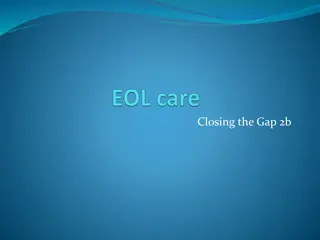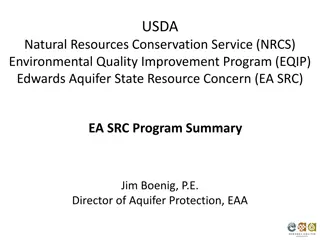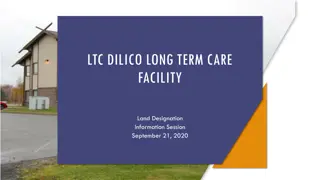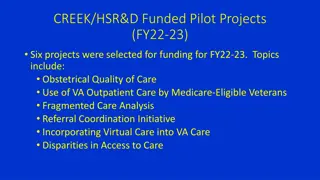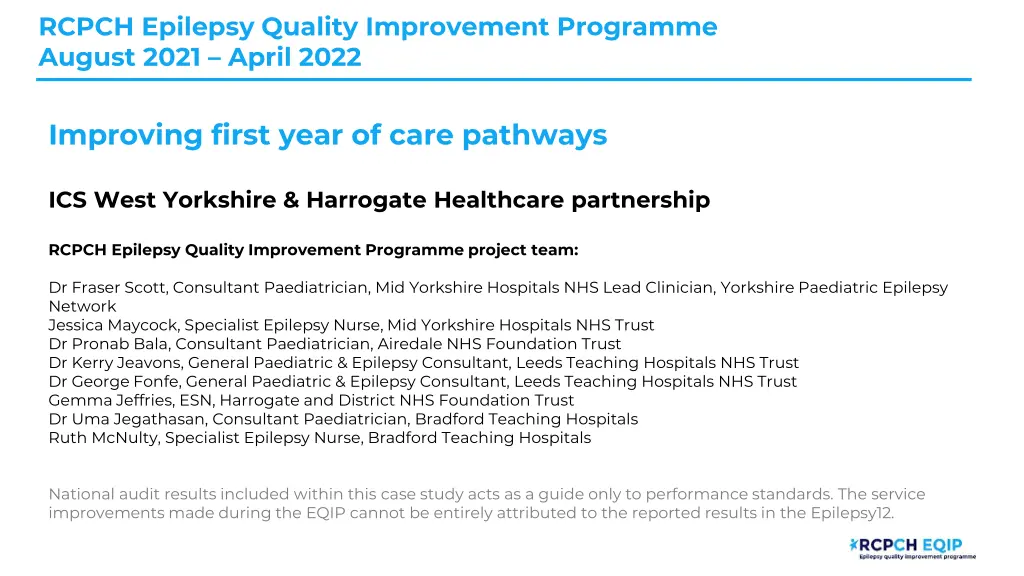
Improving Care Pathways for Pediatric Epilepsy Patients in West Yorkshire & Harrogate Healthcare Partnership
Explore the quality improvement initiative by RCPCH to enhance the first year of care pathways for children with epilepsy. The project team collaborates to standardize care pathways, reduce waiting times, improve referral processes, and engage with patients and families. Learn about the focus areas and goals of this integrated healthcare partnership in West Yorkshire and Harrogate.
Download Presentation

Please find below an Image/Link to download the presentation.
The content on the website is provided AS IS for your information and personal use only. It may not be sold, licensed, or shared on other websites without obtaining consent from the author. If you encounter any issues during the download, it is possible that the publisher has removed the file from their server.
You are allowed to download the files provided on this website for personal or commercial use, subject to the condition that they are used lawfully. All files are the property of their respective owners.
The content on the website is provided AS IS for your information and personal use only. It may not be sold, licensed, or shared on other websites without obtaining consent from the author.
E N D
Presentation Transcript
RCPCH Epilepsy Quality Improvement Programme August 2021 April 2022 Improving first year of care pathways ICS West Yorkshire & Harrogate Healthcare partnership RCPCH Epilepsy Quality Improvement Programme project team: Dr Fraser Scott, Consultant Paediatrician, Mid Yorkshire Hospitals NHS Lead Clinician, Yorkshire Paediatric Epilepsy Network Jessica Maycock, Specialist Epilepsy Nurse, Mid Yorkshire Hospitals NHS Trust Dr Pronab Bala, Consultant Paediatrician, Airedale NHS Foundation Trust Dr Kerry Jeavons, General Paediatric & Epilepsy Consultant, Leeds Teaching Hospitals NHS Trust Dr George Fonfe, General Paediatric & Epilepsy Consultant, Leeds Teaching Hospitals NHS Trust Gemma Jeffries, ESN, Harrogate and District NHS Foundation Trust Dr Uma Jegathasan, Consultant Paediatrician, Bradford Teaching Hospitals Ruth McNulty, Specialist Epilepsy Nurse, Bradford Teaching Hospitals National audit results included within this case study acts as a guide only to performance standards. The service improvements made during the EQIP cannot be entirely attributed to the reported results in the Epilepsy12.
First year of care ICS West Yorkshire & Harrogate Healthcare partnership Project aim Finalise and make progress on a WYH CYPF Epilepsy Group first year of care pathway. Establish a standardised first year of care pathway for patients with epilepsy diagnosis and improve patient information on the process (sub-projects include the areas of transition, reducing waiting times and improving referral pathways for first referral) . Background West Yorkshire and Harrogate Health and Care Partnership Children, Young People, and Families (WYH CYPF) Epilepsy Group is an Integrated Care Board (ICB) in England. It brings together all health and care organisations in six places within the Bradford District and Craven Health Care, Calderdale, Kirklees, Leeds and Wakefield. It is not a new organisation, but a new way of working to meet the diverse needs of our 2.7 million people living in the area, of whom 23% (570,000) are children and young people (CYP). Building on local plans in our six places, they have a shared commitment and a simple goal: the aim is for everyone in West Yorkshire and Harrogate to have a great start in life and the support they need to stay healthy and live longer. The WYH CYPF Epilepsy Group recognised that there currently is not a first year of care for CYP with epilepsy in the six acute Trusts, or outside of WYH, that fully captures the above. As a result, it was agreed to develop the first ICS/ICB level WYH CYPF first year of care pathway for epilepsy.
First year of care ICS West Yorkshire & Harrogate Healthcare partnership Area of focus 1. Map how we are currently performing against each of the components that make up the pathway. 2. Decide whether each Trust focuses on a different component of the pathway and shares learning or pick an area where each of the six Trusts is weakest and focus on improving standards in that area before moving on to another part of the pathway. 3. Engage with CYP and families on the first year of care pathway. Participant Trusts within the ICS and team projects Project aim Establish a standardised referral pathway to reduce waiting times for first seizure patients seen via GP and A&E To provide an equitable transition service by using group transition information sessions to young people with epilepsy aged 14, 15 and 16 years To review appointment process and reduce waiting times of over 6 months and triage overdue follow-up appointments To develop a standardised referral system for paediatric seizure, with the aim of reducing wait times to within national guidance Non-participant Non-participant Team working on which project aim Airedale NHS Foundation Trust Bradford Teaching Hospitals Leeds Teaching Hospital NHS Trust Mid Yorkshire Hospitals NHS Harrogate and District NHS Foundation Trust Calderdale & Huddersfield NHS Foundation Trust
First year of care ICS West Yorkshire & Harrogate Healthcare partnership Project outcomes Overall patients seen within 2 weeks of referral (epilepsy and non-epilepsy): 46.34%. They have achieved their aim and are looking into other areas of improving their service. While participating in the programme, the team received eight responses from patients regarding their ideas on how to improve their transition service. Unfortunately, due to significant capacity issues, the team was unable to act on the views collected from their patients. Young people with epilepsy will in the future be provided with explanations of the actions taken by the service regarding what they are trying to achieve and enable their understanding. Reduced patient consultant waiting list from a backlog of over 100 patient appointments, focusing on those with confirmed epilepsy or strongly suspicious of epilepsy. Established a reliable list of confirmed epilepsy patients awaiting review that is easily accessible by the lead consultant and ESN. The internal system for patient access to epilepsy nurse support has been demonstrated to be robust and effective. Developed a system to efficiently improve the pathway of new patient referrals received from A&E and the ward to ensure essential details were included with the referral to allow for appropriate triage within paediatric epilepsy clinics. Integrated a new process into an existing Trust guideline for new children presenting in ED and inpatient wards with suspected epilepsy. All documents accessible on the internal intranet have clear and consistent messaging. Team working on which project aim Airedale NHS Foundation Trust Bradford Teaching Hospitals Leeds Teaching Hospital NHS Trust Mid Yorkshire Hospitals NHS
First year of care ICS West Yorkshire & Harrogate Healthcare partnership Lessons learnt Many ICBs face the challenge of engaging all individual Trusts within their networks and understanding the needs of their service and the patients and families that use these services. Having a communications plan in place will help to identify the gaps in communication and information that are lacking within areas and will help to refer to and tailor information and communicate with multiple Trust level teams. Not all NHS staff are aware of who is their ICB lead, and the WYHHP is fortunate that is not the case. Like the WYHHP, ICBs should implement quarterly meetings with individual Trusts to help provide support and learning across their regents and begin to tackle variation by encouraging support for each other and sharing best practices. To increase team building and support, ICBs should form an executive team involving the ICB Clinical Lead and ICB Project Manager with individual Trust-level teams that at the very least include a clinical lead, ESN, and administrator. During the course of the EQIP, WYHHP lost their project management support, which made it increasingly challenging to obtain support for the ICB lead. Therefore, it is important that all ICBs have a project manager or coordinator in place to work alongside the ICB lead. Communication processes Team structures and dynamics
First year of care ICS West Yorkshire & Harrogate Healthcare partnership Lessons learnt Challenges and complexities There were many challenges experienced within an ICB. ICB leads have the task of engaging with Trust-level service teams that are different in population sizes and demographics. Services that are under-resourced and experience other unique challenges experienced by each service team within their region. This means ICBs will need strong leadership and process mapping tools when navigating these challenges to begin the complex task of reducing variation. All Trust service-level teams within the ICBs should be a part of a national audit or implement processes for measuring and monitoring areas of improvement, working together on their chosen quality improvement topic to share best practices and overcome challenges collectively, to begin to reduce variation. Action planning with clear measures that provide baseline local data are good ways to start problem-solving in areas of concern. Measuring/monitoring variation Visual presentation of team project intervention Team video presentation
Airedale NHS Foundation Trust ICS West Yorkshire & Harrogate Healthcare partnership (reducing waiting times) Project aim Establish a standardised referral pathway to reduce waiting times for first seizure patients seen via GP and A&E. Background Nice guidelines published first in 2004 recommend that all children who have had a first non-febrile seizure should be seen as soon as possible (within 2 weeks) by a paediatric consultant with expertise in epilepsy. This standard is not always achievable. Airedale has had an established paediatric epilepsy clinic since 2005, with an average first referral waiting time of around 10-12 weeks. Area of focus To see at least 50% of patients within 2 weeks after referral.
Airedale NHS Foundation Trust ICS West Yorkshire & Harrogate Healthcare partnership (reducing waiting times) Changes Focusing on two areas of improvement, reducing waiting times and creating a public-facing engagement document that explains the pathway of what patients and families should expect during their first year of care. Engaged A&E doctors and junior doctors regarding allocating all new seizure referrals to the team and shared the RCPCH leaflet on epilepsy first seizure. Engaged with appointment clerk to set pro forma for alerting service of patients with first seizures. New patient referrals are seen within 8-4 weeks, but the consultant is temporarily no longer on on-call shifts; therefore, the plan is to see more patients by triaging them with the aim of seeing them in the clinic within 4-2 weeks. NICE guidance on 2 week referrals is quite challenging; therefore, the project aim has changed slightly for at least 50% to be seen within 4 weeks. One appointment slot was kept free for patients referred from A&E/admissions/GP if required to be seen within 2 weeks. Monitoring progress via local data on the number of increased patients seen and the reduced waiting time.
Airedale NHS Foundation Trust ICS West Yorkshire & Harrogate Healthcare partnership (reducing waiting times) Process map of referral pathway
Airedale NHS Foundation Trust ICS West Yorkshire & Harrogate Healthcare partnership (reducing waiting times) Results Total patient referred to Epilepsy clinic: 40 (GP, A&E, Hospital admissions). From October 2021 to February 2022. Diagnosed with epilepsy: 5/40 (12.5%). Waiting time range: 1-8 weeks, mean 3.3 weeks. Waiting time after new measures: 3.3 weeks. Waiting time last year 2020: 4.3 weeks. Waiting time for epilepsy patients: 1-2 weeks. Waiting time for non-epilepsy patients mean: 3.4 weeks (37 % seen within 2 weeks). Challenges During the participation of the programme, this service experienced a lack of ESN support due to a long-term illness, leaving the consultant solely running the service. Reducing variation for first seizure referral waiting times from 8 to 2 weeks.
Airedale NHS Foundation Trust ICS West Yorkshire & Harrogate Healthcare partnership (reducing waiting times) Local data was captured on the increased number of patients seen and the reduced waiting time from 2004 to 2021.
Audit results cohort 3/4 professional input Airedale NHS Foundation Trust NICE recommends that CYP presenting with suspected seizure are seen by a specialist in the diagnosis and management of epilepsies within 2 weeks of presentation (Quality statement 1). Airedale paediatric epilepsy service have continuously been able to provide CYP with access to a paediatric consultant with expertise in epilepsy, offering a defined consultant- or associate specialist-led epilepsy clinic seeing patients at a secondary level. The percentage of CYP with input from a paediatrician with expertise increased from 85% in 2021 to 100% in 2022, achieving above regional and national averages. Percentage of CYP with input from: 2019 2020 2021 2022 2021 YPEN 2021 England & Wales 2022 YPEN 2022 England & Wales Paediatrician with expertise OR paediatric neurologist (PI.1) 90% 95% 95% 100% 82% 88% 95% 91% Paediatrician with expertise 90% 95% 85% 100% 90% 85% 96% 89% Paediatric neurologist 40% 33% 50% 30% 24% 25% 11% 20% Epilepsy specialist nurse 100% 86% 90% 95% 83% 80% 96% 80%
Audit results cohort 3/4 time since first referral Airedale NHS Foundation Trust The percentage of CYP who were seen by a paediatrician with expertise in epilepsy within 2 weeks of first referral increased to 45% in 2021, above regional and national averages. In 2022, 25% of CYP were seen within 2 weeks of first referral, achieving above the national average. The percentage of CYP who were seen by a paediatrician with expertise in epilepsy at 16+ weeks was 10% in 2021 and 5% in 2022. Time since first referral to first paediatric assessment 2019 2020 2021 2022 2021 YPEN 2021 England & Wales 2022 YPEN 2022 England & Wales 0-2 weeks 50% 38% 45% 25% 19% 23% 25% 21% 2-4 weeks 10% 33% 10% 25% 14% 12% 17% 11% 4-6 weeks 10% 5% 15% 15% 11% 9% 12% 11% 6-8 weeks 10% 5% 0% 10% 6% 7% 12% 8% 8-10 weeks 0% 5% 5% 5% 6% 5% 11% 7% 10-12 weeks 0% 0% 0% 10% 4% 3% 5% 5% 12-14 weeks 0% 5% 0% 0% 4% 3% 2% 3% 14-16 weeks 0% 0% 0% 5% 2% 2% 1% 2% 16+ weeks 0% 5% 10% 5% 20% 13% 9% 13%
Airedale NHS Foundation Trust ICS West Yorkshire & Harrogate Healthcare partnership (reducing waiting times) Outcomes Overall, the service was able to increase the number of patients seen within 2 weeks of referral (epilepsy and non- epilepsy) by 46.34%. The service has established improved relationships and engagement with ED staff. Increased effective engagement with patients and families when obtaining their views on continuous improvement and how to maintain a high standard of care. National audit results show that the percentage of CYP with input from a paediatrician with expertise increased from 85% in 2021 to 100% in 2022, achieving above regional and national averages. The percentage of CYP who were seen by a paediatrician with expertise in epilepsy within 2 weeks of the first referral increased to 45% in 2021, above regional and national averages. In 2022, 25% of CYP were seen within 2 weeks of the first referral, achieving above the national average. Lessons learnt Collaboration and engagement with other departments (A&E, appointment clerks) had a positive impact. Clear referral guidance and an efficient triaging system helped reduce waiting times. Providing RCPCH leaflets after CYP have experienced a first seizure helped families with their concerns and provided increased knowledge. Visual presentation of team project intervention: Team poster
Bradford NHS Foundation Trust ICS West Yorkshire & Harrogate Healthcare partnership (transition) Project aim To provide an equitable transition service by using group transition information sessions to young people with epilepsy aged 14, 15 and 16 years. Background Previously, the transition information session provided by children s ESN visited young people with epilepsy at home and went through the Ready, Steady, Go questionnaire to guide the discussion, which became ineffective. An internal audit was completed in January 2020, which showed that there were 84 young people with epilepsy aged 14, 15 and 16 years old on the service caseload. Only 12% of patients had received some transition input from the children s ESN. This was due to the service being 50% understaffed (RCN guidelines). Additionally, ESNs were providing group information sessions to their patients, which proved an efficient and effective method of promoting patient education. Area of focus Develop a transition information session with the aim of promoting empowerment and understanding of epilepsy to improve the quality of life for young people with epilepsy through education on the psychosocial aspects of living with epilepsy. Promote skills in communication, decision-making and assertiveness to enhance a sense of control and independence.
Bradford NHS Foundation Trust ICS West Yorkshire & Harrogate Healthcare partnership (transition) Changes Used an internal database to identify young people with epilepsy 14-16 years of age. Received eight responses collated by the children s ESN via phone using a pro forma to obtain their views on how they want the transition information session to be delivered. The team will engage the young people with epilepsy when they attend a clinic appointment to obtain their views.
Bradford NHS Foundation Trust ICS West Yorkshire & Harrogate Healthcare partnership (Transition) Results Responses from YPWE aged 14, 15, and 16 years old 75% would attend group transition information session Of which 12.5% would attend virtual group transition information session 12.5% would prefer one to one session from ESN 12.5% would prefer online eLearning session 40% would attend group transition information session during school hours 60% would attend group transition information session out of school hours Of which 20% would attend at the weekend 50% would not like their parent/carer present at transition information session 37.5% would prefer their parent/carer present at transition information session 12.5% don t know if they d like their parent/carer present at transition information session Challenges The team experienced time restraints due to being understaffed, and with no additional resources available, the team was unable to complete their EQIP project. If the data showed that preference was for one-to-one sessions, this would be very challenging for the service to take action.
Bradford NHS Foundation Trust ICS West Yorkshire & Harrogate Healthcare partnership (transition) Outcomes While participating in the programme, the team received eight responses from patients regarding their ideas on how to improve their transition service. Young people with epilepsy will in the future be provided with explanations of the actions taken by the service regarding what they are trying to achieve and enable their understanding. Beyond the EQIP, the service team plans to: Continue planning group transition information sessions with patients. Share the results of the data with patients and their families. Distribute a letter of thanks for providing their views. Lessons learnt Young people with epilepsy will need an explanation of what the service is trying to achieve to enable their understanding. Young people with epilepsy will need time to speak to the service team, either on the phone or in person in the clinic. The service will consider the views of their patients concerning how they want the transition information session to be delivered. Visual presentation of team project intervention: Team poster
Leeds Teaching Hospital NHS Trust ICS West Yorkshire & Harrogate Healthcare partnership (reducing waiting times) Project aim To review appointment process and reduce waiting times of over 6 months and triage overdue review/follow-up appointments. Background Due to limited capacity within the team due to reduced staffing and long-term sickness, referrals for new patients have increased to over 16 weeks, and overdue patient follow-up appointments with the consultant waiting lists have increased to patients waiting for over 6 months. The team chose to first focus on reducing follow-up patient lists while mapping a new referral process for first seizure patients, reducing waiting times from over 16 weeks. Area of focus Review of follow-up patient appointment pathways and quality of service provided to patients on waiting lists with the aim of reducing waiting lists.
Leeds Teaching Hospital NHS Trust ICS West Yorkshire & Harrogate Healthcare partnership (reducing waiting times) Changes The clinical lead has returned from long-term sickness and plans to review the follow-up patient appointment pathway, supporting the team. The team has uncovered that the electronic system WinDip, used within the Trust to process GP referrals, is inaccurately sending referrals to neurology instead of the paediatric epilepsy service team. The team had initial discussions regarding the waiting lists to uncover an outstanding 184 follow-up patients who are on average 6 months overdue. The team went through and reviewed the status of each patient on the list and triaged patients that needed to be seen as a matter of urgency. The team sent each patient a letter to apologise for the long waiting times and request that families contact the service to inform them of their immediate needs.
Leeds Teaching Hospital NHS Trust ICS West Yorkshire & Harrogate Healthcare partnership (reducing waiting times) Driver diagram of project plan
Leeds Teaching Hospital NHS Trust ICS West Yorkshire & Harrogate Healthcare partnership (reducing waiting times) Results Of the 184 patients on the review list: 53 had required review or medication advice. All had accessed the support offered via epilepsy nurses. 97 patients in total reviewed out of 184. Nurse clinic 4 reviews none identified they experienced any difficulties whilst waiting for overdue appointment review. Feedback: (suboptimal approach) questions were asked directly, either by a consultant or an epilepsy nurse, to the parent/carer rather than the child, but there was clear evidence that all patients had been contacted by their epilepsy service for support when needed.
Leeds Teaching Hospital NHS Trust ICS West Yorkshire & Harrogate Healthcare partnership (reducing waiting times) Challenges The epilepsy nurse response time had increased from 1 week to 3 weeks for non-urgent responses. This is a direct result of the increased volume of absences and reduced capacity within the team. The service had been resilient in terms of patient safety. Colleague morale, workload and resilience are likely to have been adversely impacted. The part-time consultant within the team carried the larger epilepsy patient workload. This meant a disproportionate deficit of epilepsy coverage was needed during the period of absence, which impacted the service hugely. There was a failure to recruit epilepsy consultant cover despite two recruitment advertisements being circulated within the Trust.
Leeds Teaching Hospital NHS Trust ICS West Yorkshire & Harrogate Healthcare partnership (reducing waiting times) Results
Leeds Teaching Hospital NHS Trust ICS West Yorkshire & Harrogate Healthcare partnership (reducing waiting times) Outcomes Through the mapping and review of follow-up patient lists, the service did not experience any serious incidents in terms of patient safety issues. Reduced patient follow-up waiting list focusing on those with confirmed epilepsy or strong suspicion of epilepsy. Established a reliable list of confirmed epilepsy patients easily accessible by the lead consultant and ESN. The internal system for patient access to epilepsy nurse support has been demonstrated to be robust and effective. The maximum wait period for a medical review was 18 months. An example of a patient being supported revealed having four ESN reviews with agreed actions and advice provided. There is potential for more nurses and non-consultant grade colleagues to increase the number of patients that can be seen and reviewed with specialist epilepsy consultant oversight. Beyond the EQIP, the service team plans to: Complete the review of the rest of the epilepsy waiting list. Explore better ways of obtaining patient feedback about the service in the affected time frame. Explore the possibility of increased colleague sessions. Explore the possibility of a dedicated registrar epilepsy clinic (historically never possible because of recurrent issues at rota level).
Leeds Teaching Hospital NHS Trust ICS West Yorkshire & Harrogate Healthcare partnership (reducing waiting times) Lessons learnt Individual patients had information reflected back to them. Patient feedback revealed that they felt they had undergone a review of their circumstances, which equipped the ESN or colleague performing the review. This review demonstrated that patients were able to follow the advice given to them by the epilepsy nurses before the next appointment date and received it appropriately, which helps to keep them safe. Visual presentation of team project intervention Team poster
Mid Yorkshire Hospitals NHS ICS West Yorkshire & Harrogate Healthcare partnership (reducing waiting times) Project aim To develop a standardised referral system for paediatric seizure, with the aim of reducing wait times within national guidance. Background NICE guidelines first published in 2004 recommend that all children who have had a first non-febrile seizure should be seen as soon as possible (within 2 weeks) by a paediatric consultant with expertise in epilepsy. Problems faced at the Mid Yorkshire paediatric epilepsy service include: The referral process is not standardised. Families receive little information about what will happen next and what to do if an event happens again. Many children are seen in the first seizure clinic when, in fact, they have not had a seizure. Most referrals do not contain sufficient detail to allow appropriate triage to decide if the first seizure clinic is the most appropriate clinic for the child. Lack of knowledge of how to make an appropriate referral. Area of focus The team's aim is to target the new referrals received from A&E and the inpatient ward in order to make the process more efficient by getting better-quality referrals.
Mid Yorkshire Hospitals NHS ICS West Yorkshire & Harrogate Healthcare partnership (reducing waiting times) Changes The team is creating a poster that will be hung in the assessment unit and on the ward on both sites so that staff know what they are meant to be doing. The team has created a slip for ED staff to fill in when they enter the referral details on the Trust system called ICE. The slip has minimal information. Staff fill in two questions as well as some basic biographic details and include a reminder of the contact details of the paediatric epilepsy service teams to share with patients and their families. The team has been engaging with juniors at handover on the wards so that they are aware of the change in process and able to support them with any queries. The team will begin evaluating the effectiveness of the process and fine-tuning any details once they begin receiving real-world data. The team has sent the paperwork out to the paediatric consultants and middle-grade consultants.
Mid Yorkshire Hospitals NHS ICS West Yorkshire & Harrogate Healthcare partnership (reducing waiting times) Changes Process mapping: old vs new
Mid Yorkshire Hospitals NHS ICS West Yorkshire & Harrogate Healthcare partnership (reducing waiting times) Results
Mid Yorkshire Hospitals NHS ICS West Yorkshire & Harrogate Healthcare partnership (reducing waiting times) Results Challenges Compliance from the team using different methods for referring patients.
Mid Yorkshire Hospitals NHS ICS West Yorkshire & Harrogate Healthcare partnership (reducing waiting times) Outcomes Developed a system in conjunction with current IT systems. After using paper methods to improve, there is a need for electronic referral. Educated staff on the use of the slip and encouraged use of the form. Incorporating information from paper form into electronic form or adapting adult form. Integrated a new process into an existing Trust guideline for new children presenting with query epilepsy. All documents accessible on the internal intranet have clear and consistent messaging. Lessons learnt It is important to create buy-in from peers and other health professionals when establishing a new process. Testing small changes at a time prevents feeling overwhelmed. Collating feedback that feeds into improvement and then measuring the changes is important when abandoning or implementing new processes. Ensure you are clear on your purpose and that your colleagues understand the purpose of change to help sustain it. Working well within a support team is beneficial. There are many complexities that exist when working within an ICS that need to be reviewed. Visual presentation of team project intervention: Team poster
https://eqip.rcpch.ac.uk eqip@rcpch.ac.uk @RCPCHEQIP

